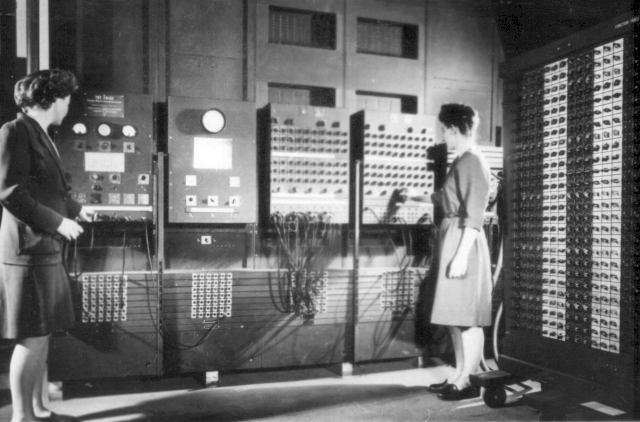| ENIAC's Women Programmers |
| Written by Sue Gee | ||||||
Page 3 of 5
Kay Mauchly AntonelliKathleen Rita McNulty (February 12, 1921 – April 20, 2006) was born in a Gaeltacht area (Irish-speaking region) of County Donegal in Ulster during the Irish War of Independence.She was the third of six children and on the night of her birth, her father, an Irish Republican Army training officer, was arrested as a suspected member of the IRA and imprisoned for two years. On his release, the family emigrated to the United States and settled in Philadelphia. At the time, Kathleen McNulty was unable to speak any English. Kay McNulty in her high school graduation portrait, 1938 At Chestnut Hill College, Kay took every mathematics course offered and graduated with a degree in mathematics in June 1942, one of only a few mathematics majors out of a class of 92 women. It was soon after graduating that she saw a US Civil Service advert looking for women with degrees in mathematics. Together with her college friend Francis Bilas she interviewed for the job of calculating bullet and missile trajectories and they were both hired as human "computers" to work at the Moore School of Engineering. During her work programming the ENIAC, Kay is credited with the invention of the subroutine. She proposed the idea to solve the problem where the logical circuits did not have enough capacity to compute some trajectories. Kay was transferred to Aberdeen Proving Ground's Ballistics Research Laboratory along with the ENIAC when it was moved there in mid-1947. She was joined by Ruth Lichterman and Francis Bilas, but the other three programmers preferred to stay in Philadelphia rather than relocate to the remote Aberdeen. On her marriage to John Mauchly in 1948 she resigned her post at Aberdeen. She worked on the software design of later computers including the BINAC and UNIVAC I computers whose hardware was designed by her husband. Frances Bilas SpenceFrances Bilas (March 2, 1922 – July 18, 2012) was born in Philadelphia, the second of five sisters.Having attended the South Philadelphia High School for Girls, she was awarded a scholarship at Chestnut Hill College where she majored in mathematics with a minor in physics, graduating in 1942. While there, she met Kay McNulty and the pair of them were hired together as computers. While working on the ENIAC project Bilas and McNulty were assigned to the operation of an analog computing machine known as a Differential Analyzer and both continued to work on ENIAC when it relocated to the Aberdeen Proving Grounds. It was there that she met Homer W. Spence, an electrical engineer who later became head of the Computer Research Branch. They married in 1947.
Betty Jean Jennings (left) and Fran Bilas Jean Jennings BartikBetty Jean Jennings (December 27, 1924 – March 23, 2011) was born in Gentry County, Missouri, the sixth of seven children. She began her education at a local one-room school, and in order to attend high school, she lived with her older sister in the neighbouring town. She subsequently attended Northwest Missouri State Teachers College and graduated in 1945. awarded the only mathematics degree in her class. She was hired by the University of Pennsylvania to calculate ballistics trajectories for Army Ordnance at the Aberdeen Proving Ground, the location where she met her future husband, William Bartik, engineer working on a Pentagon project. With Betty Holberton she became the co-lead programmer for ENIAC and it was Bartik's and Holberton's program that was chosen to introduce the ENIAC to the public and larger scientific community on February 15, 1946. She later recalled: The day ENIAC was introduced to the world was one of the most exciting days of my life. The demonstration was fabulous. ENIAC calculated the trajectory faster than it took the bullet to travel. We handed out copies of the calculations as they were run. ENIAC was 1,000 times faster than any machine that existed prior to that time. With its flashing lights, it also was an impressive machine illustrating graphically how fast it was actually computing. Bartik was the person asked to form and lead a group of programmers to convert the ENIAC into a stored program computer to enable it to operate more quickly, efficiently, and accurately. This she achieved by March 1948 working closely with John von Neumann. She went on to work with the ENIAC designers John Eckert and John Mauchly, helping them develop the BINAC and UNIVAC I computers. In the early 1950s, once the Eckert-Mauchly Corporation was sold to Remington Rand, Bartik helped trainend users how to program and use the UNIVAC for the first six UNIVACs sold, including the programmers at the United States Census Bureau and Atomic Energy Commission. For pioneering work as one of the first programmers, including co-leading the first teams of ENIAC programmers, and pioneering work on BINAC and UNIVAC I. In her acceptance speech Bartik referred to the fact that as women, she and her colleagues were indeed marginalized, saying: We did do the all the programming for the ENIAC but we were never treated as though we knew anything. When the Press came they just had us had us some act like models pretending to set switches and plug in and out cables.
<ASIN:1612480861> |
||||||
| Last Updated ( Monday, 28 April 2025 ) |

